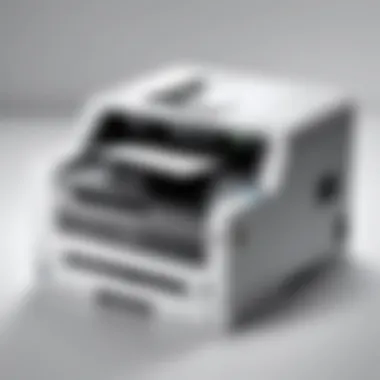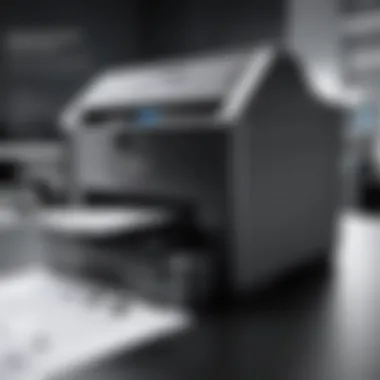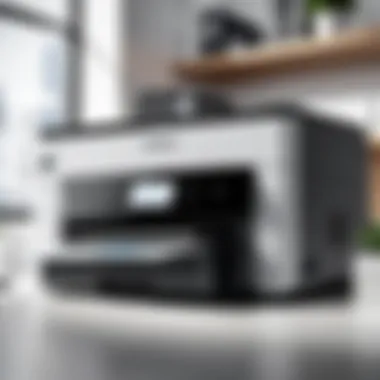Top Monochrome Laser Printers with Scanners


Intro
Monochrome laser printers with scanners have become increasingly popular in professional environments. They offer not just high-quality prints, but also the ability to scan and copy documents, making them ideal for businesses of all sizes. In this guide, we will explore the key features and specifications of the best models available today. Furthermore, we will analyze their performance through benchmark tests and real-world usage scenarios. This information is essential for IT professionals and tech enthusiasts who aim to make informed decisions when selecting their next multifunction printer.
Understanding what to look for in monochrome laser printers is crucial. Features like printing speed, resolution, connectivity options, and maintenance requirements vary significantly between models. Thus, a comprehensive evaluation is necessary to match a specific printer to workplace needs.
This article serves as an indispensable resource, enabling readers to grasp the nuances of different models. Consequently, you will learn about the functions that will best serve your organization's objectives and operational efficiency.
Intro
In today's fast-paced digital work environment, monochrome laser printers with scanning capabilities have become essential tools for professionals. Organizations prioritize efficiency, quality, and cost management, which makes understanding these devices vital. In this article, we will dive into the world of monochrome laser printers and their integral scanning features. By thoroughly analyzing these aspects, readers will discover the critical factors to consider when selecting the right printer for their needs.
Overview of Monochrome Laser Printers
Monochrome laser printers are designed to produce text and images in black and white. Their advantages include high print speeds, sharp text quality, and cost-effective printing, especially for documents that require little to no color. The technology relies on a laser to create images on a printer drum which then transfers toner onto paper. This process not only quickens output but also ensures consistency and durability of the printed materials.
Key aspects of these printers include:
- Speed and efficiency: Most monochrome laser printers can print multiple pages per minute, a crucial factor for busy workplaces.
- Cost-effective printing: The price per page is significantly lower compared to inkjet printers, especially for high-volume printing needs.
- Reliability: Their robust designs mean that monochrome laser printers often require less frequent maintenance, making them a favorable choice for many companies.
Importance of Scanning Features
The inclusion of scanning capabilities transforms the monochrome laser printer into a multifaceted office tool. Scanning documents allows for easy digitization of paper records, enabling better organization and access to important data. This feature is particularly useful for professionals who deal with paperwork regularly.
Moreover, scanning enhances collaboration among team members. Digitized documents can be easily shared via email or cloud storage, streamlining communication and reducing the need for physical copies. The benefits of built-in scanning features include:
- Increased productivity: Users can quickly scan, send, or store documents without needing separate devices.
- Versatile functionality: Many models also offer copying and faxing capabilities, maximizing utility in various work settings.
- Enhanced document management: Scanned documents can be organized digitally, making retrieval and archiving much more efficient.
This is why understanding the capabilities of monochrome laser printers with scanning functions is essential for IT professionals and tech enthusiasts alike. The subsequent sections will explore these features in more depth, enabling informed decision-making.
Key Features to Consider
Selecting the right monochrome laser printer with scanning capability necessitates careful evaluation of various key features. These features not only dictate the performance of the printer but also determine its suitability for specific tasks and environments. Understanding these elements helps IT professionals and tech enthusiasts make informed decisions that align with their needs.
Print Quality and Speed
Print quality is paramount when choosing a laser printer. It defines how clear and professional printed documents will appear. A good monochrome laser printer should offer a print resolution of at least 1200 x 1200 dpi. This resolution ensures sharp text and crisp graphics. Speed is equally important; ideally, a printer should achieve a minimum of 30 pages per minute. High print speeds enhance productivity, especially in settings with demanding workloads.
Scanning Resolution and Speed
Scanning capabilities further enrich the utility of monochrome laser printers. A high scanning resolution is essential for capturing details in documents. Look for models that offer a minimum optical scanning resolution of 600 x 600 dpi. It is important that the scanning speed is quick as well. A decent speed is around 20 images per minute for black-and-white scans. This ensures that documents can be digitized efficiently, reducing idle time in busy environments.
Connectivity Options
In a world that increasingly relies on digital integration, connectivity options are crucial. Ensure the printer supports a variety of connectivity methods. USB, Ethernet, and wireless options are highly desirable. Wireless connectivity, in particular, allows for greater flexibility in a multi-user environment. Furthermore, check for compatibility with mobile printing solutions like Apple AirPrint or Google Cloud Print, which enhance usability.
User Interface and Usability
A user-friendly interface greatly enhances the overall experience when operating a printer. Touchscreen displays are common in modern printers and should ideally be intuitive. Easy navigation through menu items can significantly reduce the learning curve. Additionally, consider the usability of the printer's software. Make sure the accompanying software is straightforward and compatible with multiple operating systems. This can ease the setup process and enhance productivity.
Top Monochrome Laser Printers with Scanners
The selection of monochrome laser printers with scanning functions holds significant relevance in today’s tech landscape, especially for professionals who require efficiency and versatility. These devices merge high-quality printing with essential scanning features, catering to the needs of various business operations. A monochrome laser printer not only provides crisp text at rapid speeds but also offers scanning functionalities that facilitate document digitization. This combination reduces the need for multiple devices, optimizing office space and resources.
In the current market, the demand for these printers continues to grow. The integration of scanning capabilities meets the requirements of businesses that need to handle various document types while maintaining a focus on cost-effectiveness and operational efficiency. Understanding the options available aids IT professionals and tech enthusiasts in making informed decisions, ensuring they select models that align with their specific needs.
Key considerations include print speed, scanning resolution, and user-friendliness. These elements contribute to productivity and overall satisfaction with the device. Thus, a careful examination of available models is essential to find the ideal fit for corporate environments.


Model Comparison
The comparison of different models serves as a foundation for understanding the performance and features of each printer. Evaluating specifications such as print speed, scanning capabilities, and connectivity options helps in discerning which model best suits your workflow. Here, factors like paper handling and memory capacity also play crucial roles. A well-rounded comparison also considers the longevity and reliability of each printer, which are critical in avoiding disruptions in operational tasks.
- Print Speed: Identifying how fast each printer can produce pages is vital, especially in high-volume environments.
- Scanning Features: Review the scanning speed and resolution to ensure quality digitization of documents.
- Connectivity: The ability to connect via Wi-Fi, USB, or Ethernet determines how seamlessly a printer can integrate into an existing office setup.
Brand A: Performance Overview
Brand A’s model showcases an impressive balance of features tailored for office use. With a print speed of up to 40 pages per minute, it guarantees efficiency. Scanning capabilities are equally robust, offering a resolution up to 600 DPI, ensuring the clarity of scanned documents. The user interface is accessible, making it easy to operate even for less tech-savvy personnel.
This brand also emphasizes energy efficiency, with its models receiving positive reviews regarding power consumption. Overall, Brand A remains a solid choice for small to medium-sized business environments.
Brand B: Performance Overview
The offerings from Brand B stand out due to their versatile connectivity options. They support both wireless and wired connections, allowing for flexible integration within office networks. This model achieves similar print speeds as Brand A but excels in scanning speed, processing documents at a remarkable rate. Positive feedback often highlights its reliability under heavy loads, which is crucial for companies that prioritize consistent performance.
Users appreciate the simplicity of maintenance, with easy access to toner and parts that often result in lower operational costs.
Brand C: Performance Overview
Brand C enters the market as a leader in cost efficiency. While the initial purchase price may be lower than some competitors, the cost per page remains competitive. These printers feature scanning resolutions on par with other models, delivering quality outputs for both printing and scanning needs. Notably, Brand C receives praise for its compact design, making it an ideal candidate for smaller offices with limited space.
However, users may find that while performance meets basic requirements, those seeking higher-end specifications should consider other models.
Brand D: Performance Overview
Finally, Brand D presents a premium option characterized by high-quality output and advanced features. This model includes additional functionalities such as duplex printing and scanning, offering significant time-saving benefits. Performance tests reveal excellent print speeds and a user-friendly interface that simplifies operations. Furthermore, Brand D’s durability is validated by positive reviews from long-term users, who often note its consistent performance in demanding environments. While it may command a higher purchase price, the features justify the investment for enterprises seeking top-tier functionality.
Performance Benchmarks
Performance benchmarks in monochrome laser printers with scanners are crucial for understanding how different models stack up in real-world applications. These benchmarks provide concrete data about various metrics, including print speed, scan speed, and cost efficiency. For IT professionals and tech enthusiasts, knowing these details helps in making informed decisions about which printer will best suit specific needs.
Print Speed Tests
Print speed is a key aspect of any laser printer. For businesses that rely on rapid document output, understanding the printer’s pages per minute (PPM) rate is vital. Various tests can assess this metric, ensuring that the printer performs at expected levels under normal operating conditions. A slower printer can lead to delays in productivity.
When evaluating models, consider the following:
- Normal Mode vs. Draft Mode: Always check speeds in both modes.
- First Page Out Time: This indicates the speed from power-up to the first printed page.
- Consistency Over Multiple Copies: It is essential to know if the printer maintains its speed over longer print jobs.
In summary, understanding print speed tests directly correlates with workplace efficiency, making it one of the most important performance metrics.
Scan Speed Tests
Similar to print speed, scan speed tests assess how quickly a printer can digitize documents. This is particularly significant for businesses that require high-volume scanning or fast archiving.
Factors influencing scan speed include:
- Flatbed vs. Automatic Document Feeder (ADF): ADFs typically provide faster scanning for multiple pages compared to flatbed scanning.
- Resolution Settings: Higher resolution may slow down the scanning process. It’s crucial to find a balance between speed and quality.
- File Format Output: Different formats can affect processing speed. For instance, PDFs might take longer to create than JPEGs.
Overall, scan speed tests indicate how efficiently a company can manage digital workflows, impacting overall productivity.
Cost Efficiency Analysis
Cost efficiency analysis examines both the initial purchase cost and ongoing operating expenses, such as toner and maintenance. Evaluating cost-effectiveness is particularly relevant for organizations that aim to keep operational budgets within limits.
Key considerations include:


- Toner Yield: How many pages can be printed from a single cartridge?
- Price Per Page: This can often be calculated based on the toner yield and the cost of the cartridges.
- Maintenance Frequency: Regular maintenance can add hidden costs over time. Choosing printers known for durability can save money.
Conducting a thorough cost analysis helps businesses avoid overspending while ensuring they select a printer that aligns with their financial expectations.
Ease of Maintenance
Maintaining a monochrome laser printer with a scanner is crucial not merely for prolonging its lifespan but also for ensuring that it consistently performs at optimal levels. This section delves into the essentials of ease of maintenance, a topic often overshadowed by features like print speed or scanning resolution. It is vital for professionals who rely on these devices for daily operations. Maintaining these printers can save your business time and money in the long run.
Toner Management
Toner management is an essential part of maintaining monochrome laser printers. Given that these printers primarily operate using toner cartridges, monitoring the toner levels is important. Regularly checking and replacing toner cartridges when necessary ensures that print quality remains high.
Using high-yield toner cartridges can reduce the frequency of replacements. Frequent changes can lead to increased downtime which impacts productivity. Sometimes, the printer may produce faded prints if the toner is low or running out. Another aspect to consider is how easy it is to replace the toner. Some models feature front-loading toner cartridges, making replacements quick and convenient. Keep in mind that the printer's design may dictate how often maintenance is needed.
In addition, consider investing in OEM (Original Equipment Manufacturer) toner vs. third-party options. While third-party toner may be cheaper, it could result in inconsistent quality or malfunctions.
Here are some practices for effective toner management:
- Regularly check toner levels.
- Use high-yield toner cartridges for extended use.
- Consider OEM toner for reliability.
- Keep spare toner cartridges on hand.
- Document usage to anticipate changes in inventory.
Hardware Upkeep
The physical upkeep of monochrome laser printers should not be overlooked. Dust and debris can accumulate inside the machine, leading to issues that affect both print and scan quality. Regular cleaning can prevent such problems, enabling devices to run effectively. Most printers offer guidelines on how often to perform these cleanings and what tools to use, which adds to the ease of maintenance.
Hardware maintenance involves several components:
- Cleaning the Printer: Use a lint-free cloth and gentle cleaning solution to wipe down the exterior and accessible interior parts. Utilize compressed air to remove dust from hard-to-reach areas.
- Inspecting and Replacing Parts: Internal components such as the drum unit may need to be inspected regularly. The life span of these parts varies, but following manufacturer recommendations can enhance performance.
- Firmware Updates: Keeping the printer's software updated can solve potential problems and improve functionality over time. Regular firmware checks can often be performed in the printer setting menu.
Maintaining hardware integrity will prevent unexpected issues that could halt productivity. From toner management to hardware upkeep, consider these factors crucial for sustained performance.
Software and Compatibility
In an era where technology rapidly evolves, software and compatibility play a crucial role in the functionality of monochrome laser printers with scanners. These elements determine not only how well the devices integrate within existing setups but also impact the overall user experience. IT professionals and tech enthusiasts must prioritize these considerations to ensure that their chosen printers not only perform efficiently but also seamlessly connect to their preferred systems and applications.
Drivers and Software Requirements
Drivers serve as the bridge between the printer and the operating system. Each printer model typically requires specific drivers to function correctly. Therefore, it is essential to verify the availability of the latest drivers from the manufacturer, such as Brother, HP, or Canon. The absence of up-to-date drivers can lead to compromised performance or compatibility issues.
Furthermore, manufacturers often provide specialized software for managing printer functions, scanning features, and utilizing advanced settings. For instance, HP offers the HP Smart app that enhances functionality. Having the correct software can unlock additional features and improve overall efficiency.
- Ensure you download drivers directly from the manufacturer's website.
- Keep an eye out for software updates to maintain optimal compatibility.
Compatibility with Operating Systems
Compatibility with various operating systems is another critical factor. Most monochrome laser printers with scanners support major operating systems, including Windows and macOS. It is essential to check the specifications to confirm that the printer can function effectively within the user's environment.
Many manufacturers also offer mobile printing options compatible with iOS and Android devices, which is significant for users who frequently print from smartphones or tablets. Utilizing such options can provide greater flexibility and convenience.
Ensure that your printer is compatible with your operating systems, as this can greatly affect your printing and scanning experience.
- Windows compatibility may require specific drivers for different versions (e.g., Windows 10 or 11).
- Many printers offer support for Linux users, though available features may vary.
- Confirm that any mobile printing feature aligns with your smartphone's OS.
User Reviews and Feedback
User reviews and feedback play a crucial role in shaping the decision-making process for potential buyers of monochrome laser printers with scanners. Understanding what actual users experience can provide unparalleled insights that specifications alone may not convey. Feedback from users can cover various aspects such as print quality, reliability, ease of use, and performance consistency. This narrative is especially relevant for IT professionals and tech enthusiasts who seek comprehensive and candid assessments of products.
In the realm of technology, user-generated insights often reveal the pros and cons that companies may not highlight. Not all printers perform the same way in diverse environments, and what works well for one user might not be as effective for another. Hence, considering reviews allows buyers to tailor their choices according to specific requirements, such as workload demands or connectivity options. This kind of personalized feedback is valuable, making it easier to assess which model truly fits operational needs.


Additionally, user reviews can shed light on real-world challenges associated with certain models. Factors like the frequency of jams, how easy it is to replace toner, or the speed of customer support from the manufacturer can significantly influence the long-term satisfaction with a product. Thus, analyzing such feedback can guide potential buyers toward informed decisions.
"User experiences can guide potential buyers better than any advertisement."
Positive Feedback Summary
Many users express satisfaction with their monochrome laser printers, particularly praising their efficient printing capabilities. Users frequently highlight the speed and clarity of the printed documents, especially when dealing with text-heavy materials. For instance, printers from brands like Brother and HP often receive commendations for fast processing times, even for larger print jobs.
Another noteworthy aspect mentioned in reviews is the scanning functionality. Users appreciate the ability to scan, copy, and print in a single machine, saving both space and time. The ease of use associated with frequently used features, such as one-touch scanning, is often highlighted in positive feedback as well. Reliable performance in various setups, whether in small offices or large enterprises, contributes to the favorable opinions shared by users.
Common Complaints
Despite numerous positive reviews, common complaints among users also reveal areas for improvement. One recurring issue is the high cost of replacement toner cartridges. Many users express frustration over the expense, especially if the printer offers lower-than-expected page yields.
Some users have noted concerns regarding the printer's connectivity options. While many newer models boast wireless capabilities, issues such as dropped connections or difficulties in setting up network options can lead to negative experiences. Furthermore, reports of software bugs or compatibility issues with specific operating systems occasionally arise, leading to said dissatisfaction.
In summary, while user reviews and feedback are instrumental in understanding the value and functionality of monochrome laser printers with scanners, they offer a balanced view of both the strengths and weaknesses of devices in this category. Listening to existing users can help potential buyers make informed choices.
Cost Analysis
Cost analysis plays a crucial role in evaluating monochrome laser printers with scanners. Understanding costs associated with these devices assists IT professionals and tech enthusiasts in making informed decisions grounded in financial prudence. The cost of a printer goes beyond the initial purchase price; it encompasses various elements such as ongoing maintenance and operational expenses. Thus, a comprehensive cost assessment can indicate the total financial commitment related to the printer over its lifespan.
A well-executed cost analysis ensures that users effectively gauge the economic viability of their investment. It encourages a more holistic understanding of what each model offers in terms of functionality relative to its price. This leads to better alignment with budget constraints and reduces the risks of underestimating operational costs over time.
Initial Purchase Cost
The initial purchase cost refers to the upfront expense required to acquire a monochrome laser printer with scanning capabilities. This cost varies significantly depending on brand reputation, model specifications, and included features. High-end models may offer advanced functionalities but often come with a higher price tag.
When evaluating initial purchase costs, consider the following factors:
- Brand: Established brands like Canon, HP, and Brother often charge more, reflecting their reliability.
- Features: Printers with impressive scanning abilities or higher printing speeds might demand a premium.
- Warranty and Support: Devices with extended warranty coverage can save expenses in potential repairs in the long run.
An itemized list of features in each model can aid in finding the best value for money. It is essential to strike a balance between affordability and necessary features to ensure longevity in usage.
Operating Costs Evaluation
Operating costs represent recurring expenses incurred during the printer's lifecycle. This often includes toner replacement, maintenance, and energy consumption. Understanding these aspects helps to project a more accurate financial picture, ensuring that one does not overlook crucial expenses.
Key elements to evaluate when considering operating costs are:
- Toner Expenses: Toner cartridges can be a significant part of the printer's operating costs. Some models feature high-yield cartridges that reduce the cost per page.
- Energy Consumption: Printers that implement energy saver modes can contribute to lower electricity bills. Checking the Energy Star rating can offer insight into power efficiency.
- Maintenance and Service: Routine maintenance such as cleaning and repairs can add to the overall costs. Checking customer reviews on durability and support will help predict these expenses.
"A thorough understanding of both the initial and operating costs lays the foundation for a solid investment in monochrome laser printers with scanners."
Evaluating operating costs together with initial purchase prices will provide a more comprehensive view to buyers. Ultimately, diligent cost analysis enables informed decisions that fit financial guidelines without compromising on quality.
Closure
In this final section, we will emphasize the vital importance of understanding monochrome laser printers with scanning features. As professionals navigate a technology-filled world, making informed choices in equipment is significant. Choosing the right printer can greatly influence efficiency and productivity.
Summary of Findings
Throughout the article, we outlined the myriad features of monochrome laser printers equipped with scanners. These devices are not just printers; they integrate scanning capabilities that streamline various tasks in offices and home setups. Important factors include print quality, speed, and cost-effectiveness, which affect the overall user experience.
Many models have been praised for their reliability and performance. Certain devices have standout characteristics, such as enhanced scanning resolution and optimized connectivity options, ensuring that they meet diverse operational demands. The benchmarks provided earlier give insight into how specific models rank within professional settings.
Final Recommendations
When selecting a monochrome laser printer with a scanner, several considerations must be taken into account. Firstly, evaluate individual needs—are high-speed prints critical, or is overall print quality more important? Depending on the workload, brands like Brother, HP, and Canon provide options that cater to different user requirements.
Next, consider the balance between initial purchase price and long-term operating costs. Investing in a higher-end model may yield savings over time, particularly in a high-volume environment.
In summary, it is crucial to assess available options, weighing capabilities against user needs. Such deliberation will not only enhance productivity but also contribute to cost efficiency in the long run. By following the analysis in this guide, professionals can navigate the selection process more effectively and ultimately invest in a printer that aligns with their unique requirements.



